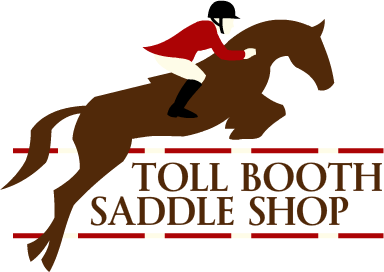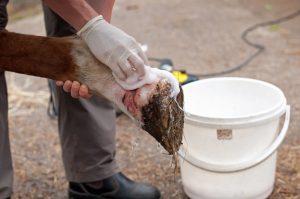Wounds: When to Call the Vet
Katharine J Porter, VMD
We all know the scenario: You head out to the barn to feed, or to bring your equine partner in from a day of turnout, and see that somehow, despite all your precautions, your horse has managed to sustain a wound. After the initial dismay of how your horse could have possibly injured himself, you are faced with the question: Do I need to call the vet or can I manage this wound on my own? One sure and steadfast rule is that it is NEVER wrong to call your veterinarian if your horse has a wound, or if you have any concerns or questions. Otherwise, listed below are a few characteristics to look for when you are evaluating a wound on your horse that would indicate the wound should be evaluated by a veterinarian.
- Full Thickness Lacerations: Full thickness lacerations extend entirely through the skin (the epidermis and dermis), exposing or involving deeper tissues. A trick to determine if a wound is full thickness is to place a clean or gloved finger (if your horse will allow you to safely do so) on one skin edge and pull back. If the opposite skin edge moves with your edge, the wound is partial thickness at that location (a laceration may only be full thickness at certain sections along the length). If the opposite edge does not move, the wound is full thickness at that section. If you are unsure, remember it is never wrong to call your veterinarian. Depending on the location of the wound, deeper tissues involved may include subcutaneous fat, muscle, tendons and ligaments, synovial structures (joints, tendon sheaths, bursa), and bone. These wounds are important to have evaluated in order to assess for involvement of deeper tissues or structures and appropriately address and treat all involved structures. Many full thickness wounds can also be sutured to allow for quicker and more cosmetic healing.
- Puncture Wounds: Puncture wounds are always concerning but often overlooked wounds. A small entry point on the skin may seem innocuous, but puncture wounds should always be evaluated to determine the extent and direction of the wound tract and appropriately address involvement of deeper structures. It is important to remember that the wound tract resulting from a puncture wound can extend in any direction from the initial point of entry observed on the skin, and may contain foreign material from the puncturing object. A veterinarian can evaluate these wounds thoroughly to determine the extent of the wound tract, determine and address any deeper structures involved, address any foreign material remaining in the wound, and direct subsequent care to help prevent infections and complications as the wound heals.
- Eye and Eyelid Wounds: Wounds near the eye are concerning because of potential involvement of the eye itself. If it appears your horse has had any trauma around his eye, it is best to have the eye thoroughly evaluated for any injury that should be treated, especially if you notice any squinting or tearing. Eyelid lacerations are also very important to appropriately address and repair, as eyelid defects can permanently affect the future health of your horse’s eye.
- Distal Limb Wounds: Horses have very little fat and muscle on their distal (lower) limbs, which helps make them the athletic creatures we love, but also means that vital structures, including bone, tendons, ligaments, and synovial structures are superficial (close to the skin surface) and relatively unprotected. As a result, wounds on the distal limb can easily involve these deeper structures, and it is important that a veterinarian thoroughly evaluates for and addresses any involvement of deeper structures.
- Dirty Wounds or Wounds Containing Foreign Bodies: Even in an otherwise simple wound, wounds that are contaminated or contain foreign material (wood, shavings, metal, debris) are prone to infection and complications if not appropriately addressed. A veterinarian will be able to thoroughly clean, flush, evaluate for and remove foreign material from, and debride (remove contaminated tissue) these wounds, and direct subsequent care to help prevent infections and complications as the wound heals.
- Significant Heat, Pain, Swelling, Bleeding, or Discharge Associated with Wound: Remember a skin wound indicates a traumatic event and a skin wound may only be one aspect of your horse’s injury. Heat, pain, swelling, bleeding, and discharge are all signs that may indicate more substantial injury. If you notice these signs develop with a seemingly simple wound that you have been managing, it may indicate complications with wound healing, such as infection, or more substantial injury than initially thought. In either scenario it is important for a veterinarian to evaluate for and address all injuries associated with the wound, and evaluate for and address any complications.
- Horse is Not Vaccinated: Tetanus is a deadly and preventable disease caused by the bacteria Clostridium tetani, which is found in soil and manure. Your horse should receive yearly boosters for tetanus, among other easily preventable but devastating diseases, but if your horse has not been recently vaccinated, or if your horse is due for annual vaccines, an immediate booster can be administered by a veterinarian.
- You Feel Wound Requires NSAIDs (Bute or Banamine) or Antibiotics: Most horse owners are familiar with administration of NSAIDS and antibiotics, and you can usually find a variety of left-over medications in the barn. If you are concerned enough about a wound that you feel your horse needs medication, you are concerned enough to call your veterinarian. It is important for your veterinarian to evaluate the need for any medication, determine which medications would be most beneficial to your horse with minimal side effects, and instruct appropriate dosing and duration for medications.
About the author: Dr. Porter is an associate large animal veterinarian at Rancocas Veterinary Associates in Mount Holly, NJ. She grew up riding ponies and thoroughbreds and currently enjoys spending her free time with her two horses, Blondie and Junior. If you have any veterinary questions or concerns please feel free to contact Rancocas Veterinary Associates at 609-261-7280, on the web at www.rancocasvet.com, or through Facebook at www.facebook.com/rancocasvet.



Recent Comments